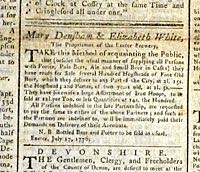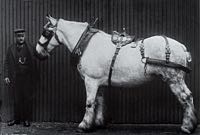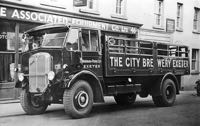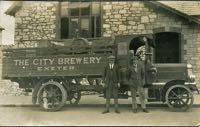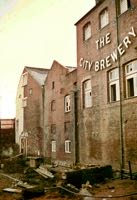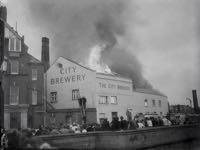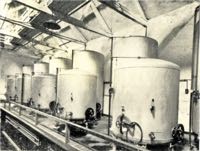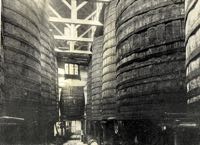
The City Brewery (Norman & Pring)
Commercial Road
Page added 3rd February 2015
Return to Industrial Exeter
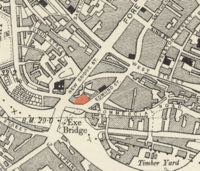 At a time when pure, clean water was not readily available, beer was drunk by all classes, and ages. Boiling the water to make beer, ensured that bacteria was killed off, avoiding cholera and other water bourne diseases. For this reason, In the middle of the 17th century, Robert Vilvaine,
an Exeter doctor gave to the City Chamber a piece of ground for a brewhouse. "He likewise purchased of the Mayor and
Chamber, for a term of 999 years, a piece of ground, in Exe Island, on
which he built a large Brewhouse, with a Malthouse adjoining, called
the Public Brewhouse, which he gave to the Chamber...." (Jenkins)
At a time when pure, clean water was not readily available, beer was drunk by all classes, and ages. Boiling the water to make beer, ensured that bacteria was killed off, avoiding cholera and other water bourne diseases. For this reason, In the middle of the 17th century, Robert Vilvaine,
an Exeter doctor gave to the City Chamber a piece of ground for a brewhouse. "He likewise purchased of the Mayor and
Chamber, for a term of 999 years, a piece of ground, in Exe Island, on
which he built a large Brewhouse, with a Malthouse adjoining, called
the Public Brewhouse, which he gave to the Chamber...." (Jenkins)
In 1653 Simon Snow's will stated "I give and bequeath to the Corporation of the city of Exeter, and their successors for ever, all that brewhouse and malthouse, called the Common Brewhouse, lately erected near the Duckingstool Mills, in Exe Island" (Jenkins)
The Duckingstool Mill became known as the Round Tree Mill. The City Brewery, would appear on the site of the Common Brewhouse.
On 15th September 1760, a lease was agreed by the Mayor, Bailiffs and Commonalty of the City of Exeter to Richard Densham who built a cellar and warehouse on the site beside the Common Brewhouse. Situated on the old Exe Bridge, the site it had a leat running behind and the river in front. Richard Densham went into partnership in 1786 with Samuel White and over the next few years, the brewery took on other partners. An advert in Andrew Brice's Old Exeter Journal of July 1776 gives the proprietors of the Exeter Brewery as Mary Densham and Elizabeth White. It refers to the late partnership and lists the products and prices per hogshead from the brewery. This was a brewery supplying local inns, taverns and large households and individuals. The first lease to mention the City Brewery was dated 1801.
In 1833 the brewery was growing, using the common method of acquisition, and they purchased the St Thomas Brewery (Malthouse), which had existed at Shooting Marsh Stile from 1789. The St Thomas Brewery was both a brewery and malthouse - the building is now the Malthouse family restaurant and pub. Then, in 1834, the partnership of Messrs Benjamin Salter, Thomas Owen Snr and Thomas Owen Jnr was formed. In 1844 the Exeter Brewery in Mermaid Yard was acquired. It was in 1845 that Benjamin Salter sold his interest in the brewery to John Evomy Norman. Various other partnership changes occurred with death and individual bankruptcy. Walter Pring, the second and last major player in the formation of the brewery, became a partner in 1865, forming Norman and Pring. It wasn't until July 1911 that the brewery became a limited company.
The Commercial Road premises was a prominent site on the old Exe Bridge, overlooking the river. Cellars, parallel with the road contained large vats of 310 barrel capacity for storing stout and porter. From 1454, an English barrel contained 36 gallons of beer or 32 gallons of ale giving 11160 gallons per vat. The vats were removed in the 1920's and replaced with glass-lined conditioning tanks for the increasing bottled beer trade. A bottling store between Commercial Road and Frog Street was also commissioned in the 1920's, followed in 1937 by the first automatic bottling plant.
Clean as a Whistle!
Mr
Cyril Brown recalled in the Express & Echo, of when in the
1920's he worked for the City Brewery. He normally worked as a chimney
sweep, but he would work for the City Brewery to shovel the barley
residue out of the giant mash tuns. He had to enter the tun after the
liquid had been drained and shovel out the contents as it was still
steaming hot, into waiting farm carts. The residue was fed to cattle.
When he was finished, he would emerge, pouring with sweat, but as clean
as a whistle. As good as turkish bath!
For a thousand years, Exeter's mills were driven by water wheels installed in the leats. The City Brewery was no exception, as its machinery was driven by two water wheels. In 1929, one of the wheels was replaced by a turbine and generator - the second wheel operated until 1953. Water for the brewery was supplied from three wells until the 1950's when water was taken from the public supply.
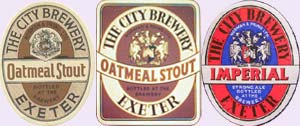 In 1943, St Anne's Well Brewery and Norman and
Pring merged. In 1955, Whitbread made an alliance with Norman and
Pring, when the Exeter brewery became an umbrella brewery of Whitbread
for sharing marketing and distribution. In 1962, Whitbread made an
offer of £1.3 million to take over Norman and Pring, along with
their 168 public houses, which was accepted. In 1967, Norman and Pring
(part of Whitbreads) amalgamated with another Whitbread brewery,
Starkey, Knight & Ford and relocated to Tiverton, and the City
Brewery premises were put up for sale. In July of the same year, fire
raged through the brewery, and 30ft flames leapt through the roof. The
fire service put the cause down as sparks from oxy-equipment that was
being used to dismantle the vats. The building of the Exe Bridge road
system in the early 1970's saw the whole area demolished and the leat
that drove the water wheels filled in, leaving grass, pavement and road
covering the old breweries site.
In 1943, St Anne's Well Brewery and Norman and
Pring merged. In 1955, Whitbread made an alliance with Norman and
Pring, when the Exeter brewery became an umbrella brewery of Whitbread
for sharing marketing and distribution. In 1962, Whitbread made an
offer of £1.3 million to take over Norman and Pring, along with
their 168 public houses, which was accepted. In 1967, Norman and Pring
(part of Whitbreads) amalgamated with another Whitbread brewery,
Starkey, Knight & Ford and relocated to Tiverton, and the City
Brewery premises were put up for sale. In July of the same year, fire
raged through the brewery, and 30ft flames leapt through the roof. The
fire service put the cause down as sparks from oxy-equipment that was
being used to dismantle the vats. The building of the Exe Bridge road
system in the early 1970's saw the whole area demolished and the leat
that drove the water wheels filled in, leaving grass, pavement and road
covering the old breweries site.
Sources - The Land of Bill Brewer, Express & Echo, Financial Times, Morning Advertiser, Trewman's Exeter Flying Post, Izacke, the Exe Island and the City Brewery by Pring, Jenkins and Hoker histories, Heavitree by Hazel Harvey, Ordnance Survey map 1876, Carl Mortimer and lastly, Steve Coombes
│ Top of Page │
